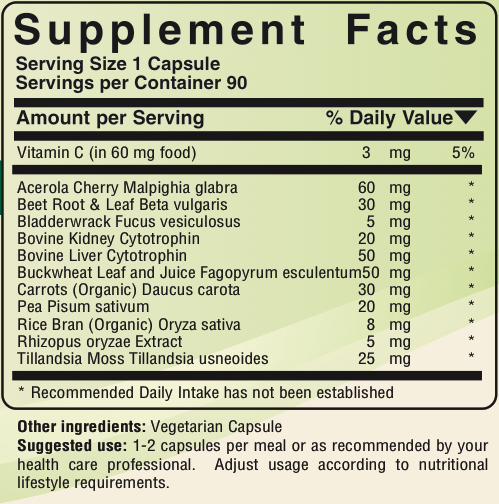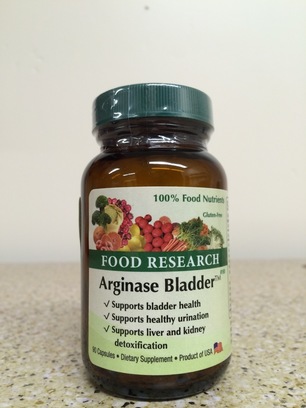
Arginase Bladder
90 Capsules $24.98
90 Capsules $24.98
Urination is something many people think little about unless something goes wrong. From excessive urination, to nocturnal enuresis to urinary tract infections to urinary incontinence, urination issues are problems for many.
Most people do not realize that in order to produce urine, the body processes liquids into an intermediate stage which is high in the amino acid called arginine. Normally the liver produces enough of the enzyme arginase to convert and concentrate this liquid into urea (urine) [1]. When it does not, however, in some people this seems to cause the body to try to expel this high arginine liquid excessively, both day and night.
Decades ago a nutrition-based biological process was developed to assist the body with this aspect of urine metabolism . And now, there is actually one and only one 100% food product that utilizes this special biological process without any USP “nutrients” called Arginase Bladder. It has been written that this type of product is indicated sometimes when there is “[p]ain in area of kidneys or bladder (may radiate through dorsal region to liver area) burning on urination; uremia, uriniferous odor of breath, itching of skin from “salty” (residue) perspiration; edema; ascites, dropsy, etc.; toxemia, body odor, pasty skin, biliousness; liver disease, enlargement, diminished urination, veinous congestion, etc….a valuable adjunct in all problems involving the liver and kidneys, particularly where this is evidenced by systemic manifestations involving the detoxification mechanisms and fluid balance” [2].
It is a scientific fact that, “Arginase hydrolyzes arginine to urea”. In addition to raising serum arginine levels, arginase deficiency can lead to raised ammonia levels [3]. Arginase is produced in the liver [1,3].
Arginase Bladder contains ingredients which have been used to nutritionally support the bladder and various aspects of urine metabolism.

Acerola Cherry is one of the most vitamin C dense foods [4]. Arginase is activated by vitamin C [5]. One study found that vitamin C taken prophylactically by pregnant and nursing mothers could reduce the incidence of urinary tract infections [6].
Beet and rice specially processed with Rhizopus oryzae and Tillandsia usneoides has long been used to support, “Intermediate processes involving urea metabolism which support liver and kidney function where toxic overload places stress on these organs” [2]. Many decades ago, Royal Lee, Bill Hansen, and David Roderick worked together. A special type of biological process for urinary support was developed around that time that David’s son Steven Roderick uses for Arginase Bladder. Beets themselves have long been used for kidney and bladder disorders [7].
Bovine kidney supplies kidney tissue. Kidney tissue naturally contains kidney enzymes, proteins, and other peptides needed for proper renal function. “The kidneys perform their most important functions by filtering the plasma and removing substances from the filtrate at a variable rate, depending upon the needs of the body. Ultimately, the kidneys ‘clear’ unwanted substances from the filtrate (and therefore from the blood) by excreting them in the urine while returning substances that are needed back to the blood…Urine formation begins with filtration of large amounts of fluid through the glomerular capillaries into Bowman’s capsule…The kidney conserves water by excreting a concentrated urine” [8]. Helping concentrate urine also reduces the possibility of urinary tract infections, and reduces extra trips to the restroom. Kidney tissue is recommended for urinary tract infections and to strengthen the kidneys [9].
Bovine liver supplies liver tissue. Bovine liver tissue contains the substances naturally found in the liver, like arginase [1]. In order to convert the high arginine intermediate substrate into urea and orthinine, the body uses the enzyme arginase. “The liver has the greatest amount of this enzyme, and accounts for the majority of urea synthesis…[a] small amount is carried out by the kidney and brain…the hydrolysis of arginine to urea and orthinine makes possible the urea cycle” [1]. An excess accumulation of arginine (due to insufficient arginase) contributes to excessively frequent urination (as the body tries to flush this diluted semi-urine out) and increases in urinary tract infections (as this less concentrated semi-urine is a less hostile environment for pathogens than concentrated urine is). “The liver is well known for its ability to detoxify or excrete…many drugs…hormones” and other substances” [8]. The bovine liver tissue found in Arginase Bladder is from New Zealand.
Buckwheat juice and seed has long been used as part of nutrition to support the intermediate processes involving urea metabolism and “support liver and kidney function where toxic overload places stress on these organs” [2]. “A 20% drop in systolic level is not unusual in the initial stages, progressively lowering under long term use. Importance of protracted treatment should be stressed” [10]. Though most often recommended for capillary and venous health (i.e. bruising, varicose veins) [10,11], naturopaths, chiropractors, and holistic doctors have long recommended its leaves or its immune supporting components in products to fight viral and bacterial infections [9,12,13]. In addition to containing chlorophyll, presumably active components include rutin, quercitin, and hyperoside [11] (it also contains other semi-unique Food substances that may be actively needed). It should be noted that, despite its name, buckwheat is not taxonomically related to wheat, and is often used in gluten-free, wheat-free diets [14].
Carrots are probably the highest concentrated Food source of the vitamin A precursor beta carotene. “Scientists in India have discovered that carrots afford significant protection for the liver” as carrots contain substances which “increase the activity of several enzymes that speed up detoxification of the liver and other organs” [15]. Carrots appear to have some bladder protection benefits [16].
Goat bladder supplies bladder tissue. Bladder tissue naturally contains the peptides and enzymes that the bladder needs for nutritional support. “The urinary bladder…is a smooth muscle chamber composed of two main parts: (1) the body, which is the major part of the bladder in which urine collects, and (2) the neck, which is a funnel-shaped extension of the body…connecting with the urethra…sensory fibers detect the degree of stretch in the bladder wall. Stretch signals from the posterior urethra are especially strong and are mainly responsible for bladder emptying” [8].
Peas have been shown to contain a substance that has “arginine decarboxylase (ADC) activity” [17]. This means that it can help break carbon away from arginine [1,8]. Peas have long been part of arginase related products [i.e. 2].
People simply take 100% Food Arginase Bladder to feel better.
References
[1] Bondy PK, Rosenberg LE. Duncan’s Diseases of Metabolism, 7th ed. W.B. Saunders Co., Phil., 1974
[2] Lee R. Arginex. In Product Bulletins, circa 1950
[3] Iyer R, Jenkinson CP, Vockley JG, Kern RM, Grody WW, Cederbaum
S. The human arginases and arginase deficiency. J Inherit
Metab Dis. 1998;21 Suppl 1:86-100
[4] Hendler SS, Rorvik D, eds. PDR for Nutritional Supplements. Medical Economics, Montvale (NJ), 2001
[5] Ruskin SL High Dosage Vitamin C in Allergy. Am J Dig Dis. 1945;12(9):281-313
[6] Ochoa-Brust GJ, Fernández AR, Villanueva-Ruiz GJ, Velasco R,
Trujillo-Hernández B, Vásquez C. Daily intake of 100 mg ascorbic
acid as urinary tract infection prophylactic agent during
pregnancy. Acta Obstet Gynecol Scand. 2007;86(7):783-787
[7] Ingram C. Super-Market Remedies. Knowledge House, Buffalo Grove (IL), 1998, p. 82
[8] Guyton AC, Hall JE. Textbook of Medical Physiology, 9th ed. WB Saunders, Phil., 1996
[9] Balch JF, Balch PA. Prescription for a Nutritional
Healing, 2nd ed. Avery Publishing, Garden City Park (NJ), 1997
[10] Lee R. Cyruta. In Product Bulletins, circa 1950
[11] Gruenwald J, Brendler T, Jaenicke C, eds. PDR for Herbal
Medicine, 4th ed. Thompson PDR, Montvale (NJ), 2007
[12] Thiel R. Serious Nutrition for Health Care Professionals, 2n
ed. Center for Natural Health Research, Arroyo Grande (CA), 1996
[13] Versendaal DA. Contract Reflex Assessment and Applied
Trophology. Dr. D.A. Versendaal, Holland (MI), 1990
[14] Hafstrom I, Ringertz B, Spangberg A, et al, A Vegan Diet Free of
Gluten Improves the Signs and Symptoms of Rheumatoid Arthritis: The
Effects on Arthritis Correlate With a Reduction in Antibodies to Food
Antigens. Rheumatology, 2001;40:1175-1179
[15] Duke JA. The Green Pharmacy. Rodale Press, Emmaus (PA), 1997
[16] Mettlin C, Graham S. Dietary risk factors in human bladder cancer. Am J Epidemiol. 1979;110(3):255-263
[17] Perez-Amador MA, Carbonell J. Arginine Decarboxylase and
Putrescine Oxidase in Ovaries of Pisum sativum L. Changes during Ovary
Senescence and Early Stages of Fruit Development). Plant Physiol.
1995 Mar;107(3):865-872
Some of these studies (or citations) may not conform to peer review standards. Therefore, the results are not conclusive. Professionals can, and often do, come to different conclusions when reviewing scientific data. None of these statements have been reviewed by the FDA. All products distributed by Doctors’ Research, Inc. are nutritional and are not intended for the treatment or prevention of any medical condition.
 |
||
|
||
